Physical Address
304 North Cardinal St.
Dorchester Center, MA 02124
The range of conditions presenting as “hard skin” is broad, including those diseases that cause cutaneous sclerosis (increased connective tissue with normal or decreased fibroblasts) and those that cause cutaneous fibrosis (increased connective tissue and increased fibroblasts).
The clinical differential diagnosis of “hard skin” can be divided into two main categories: morphea and morphea-like conditions and systemic sclerosis and sclerodermoid conditions.
Patients with morphea and morphea-like conditions tend to have more asymmetric, discontinuous skin involvement, while patients with systemic sclerosis and sclerodermoid conditions tend to have more symmetric, distal, and continuous skin involvement.
The presence of sclerodactyly, nailfold capillary changes, and Raynaud’s phenomenon are useful in distinguishing systemic sclerosis from other causes of hard skin.
The term “scleroderma” is frequently used in reference to both localized (morphea) and systemic (systemic sclerosis) conditions presenting with “hard skin.” While both morphea and systemic sclerosis (SSc) share a common endpoint of cutaneous sclerosis with identical histologic features, key differences in their pathophysiology, autoantibody profile, and clinical presentation suggest they represent separate disease processes rather than a spectrum. Importantly, morphea does not evolve into SSc, and patients with morphea do not develop the specific internal organ manifestations of SSc. As a general rule, patients with morphea tend to have more asymmetric, discontinuous skin involvement, and patients with SSc tend to have more symmetric, distal, and continuous skin involvement. Thus, the differential diagnosis of “hard skin” can be separated into two main diagnostic categories: morphea and morphea-like conditions and systemic sclerosis and sclerodermoid conditions.
Morphea (localized scleroderma) occurs in both adults and children and may present as one or more edematous, indurated, or atrophic plaques. Morphea is typically erythematous or violaceous in its active (or inflammatory) phase ( Fig. 3-1 ) and ivory-colored or hyperpigmented in its damage (or noninflammatory) phase. Morphea is distinguished from SSc based on the absence of sclerodactyly, Raynaud’s phenomenon, and nailfold capillary changes. The term “morphea” may be preferred over “localized scleroderma” to emphasize the distinction from SSc and its specific end-organ complications. Extracutaneous manifestations of morphea can include involvement of underlying structures such as bone and, in cases of linear morphea affecting the head, the central nervous system. Arthralgias may also be present (e.g., 10% of pediatric patients) ( ). ANA (antinuclear antibody) positivity is observed in 20% to 80% of patients with morphea, but is generally not indicative of an underlying systemic autoimmune connective tissue disease such as lupus erythematosus or SSc.
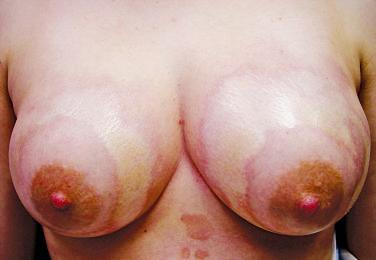
While the classification of morphea subtypes has been controversial, one of the more commonly used systems proposed by Laxer and Zulian describes five morphea variants based on clinical manifestations: circumscribed, linear, generalized, pansclerotic, and mixed variants. Circumscribed morphea, the most common subtype in adults, presents with up to three individual plaques. Active lesions often demonstrate a characteristic indurated lilac rim ( Fig. 3-1 ); they may expand or burn out, becoming ivory-white or hyperpigmented and softening over several years. Both superficial (more common; limited to the epidermis and dermis) and deep (involving the deep dermis and subcutaneous tissues) variants of circumscribed morphea have been described.
Linear morphea presents as a band of sclerotic, depressed skin, frequently with overlying hyperpigmentation. Linear morphea is most common in children and affects the limbs, face, and/or scalp, typically as a single lesion ( Fig. 3-2 ). In children, linear morphea of the limbs can cause focal growth arrest and limb length discrepancies due to disruption of the growth plate. Joint contractures are a particular concern when the lesion crosses a joint. The head variant of linear morphea includes two subtypes: en coup de sabre (ECDS; frontoparietal linear morphea) and progressive hemifacial atrophy (PHA; Parry Romberg syndrome). En coup de sabre ( Fig. 3-3 ) most often presents as a depressed and/or hyperpigmented plaque on the paramedian forehead; when the lesion extends into the scalp, prominent alopecia may be observed. Early in its course, ECDS can present as an erythematous patch mimicking a port wine stain. In contrast, PHA predominantly affects the subcutaneous tissues, sometimes with only subtle changes of overlying skin. Overlapping features of both ECDS and PHA in the same patient are not uncommon. Head variant linear morphea is associated with central nervous system and eye abnormalities. Central nervous system manifestations include seizures and headaches, reported in 13% and 9% of patients, respectively. The severity of skin findings is not predictive of CNS abnormalities, and a magnetic resonance image (MRI) with contrast is helpful to guide management. Ocular manifestations may be present in 3% of patients with head variant linear morphea, with common features including adnexal sclerosis and uveitis; detection by serial ophthalmologic examinations may help prevent permanent visual loss. Dental abnormalities may also be present, particularly in patients with PHA. Although most common in children, linear morphea may also present in adults.
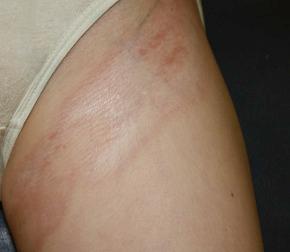
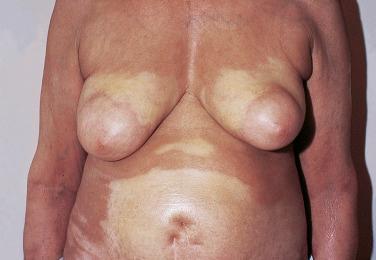
Generalized morphea describes the presentation of four or more indurated plaques, larger than 3 cm each, involving two or more separate anatomical areas ( Fig. 3-4 ). Arthralgias may be more prevalent than in other morphea subtypes. Patients with generalized morphea are more likely to have positive autoantibodies. Severe generalized morphea can be distinguished from SSc based on the absence of Raynaud’s phenomenon, nailfold capillary changes, and sclerodactyly.
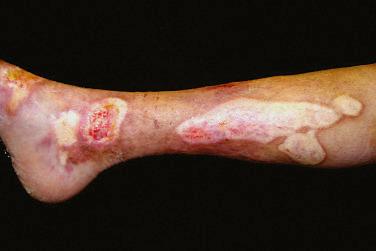
Pansclerotic morphea is a poorly defined, very rare, and aggressive morphea subtype, which has been proposed by some authors to be a variant of generalized morphea. Pediatric patients in particular may have circumferential and subcutaneous involvement, affecting nearly the entire body surface area. Pansclerotic morphea may also present with full-thickness involvement of the underlying muscle, tendon, and bone, with associated nonhealing ulcers and cutaneous squamous cell carcinoma.
Up to 15% of morphea patients present with a combination of two or more of the previously discussed subtypes, or the “mixed subtype” variant. Other entities that may fall along the morphea spectrum include lichen sclerosus and eosinophilic fasciitis (discussed separately later in this chapter). Genital lichen sclerosus has been reported to occur with greater than average frequency in individuals with plaque, linear, and generalized morphea; a genital exam is ideally included in the care of patients with morphea. Whether lichen sclerosus truly falls along the morphea spectrum ( Fig. 3-5 ) or is an associated condition requires further clarification.
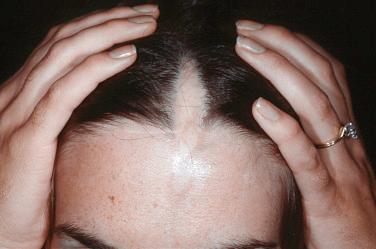
The diagnostic approach to morphea includes characterization of the extent and location of involvement as well as exclusion of other common morphea mimics or morpheaform disorders ( Table 3-1 ). Morphea is generally a clinical diagnosis, and skin biopsy may not be required in typical cases. Morphea and SSc are indistinguishable on biopsy. Skin biopsy may nevertheless be useful when atypical findings are present and/or to assess the severity of active inflammation when considering treatment options. Biopsy specimens from well-developed lesions should include underlying subcutaneous tissue and are square in appearance histologically (the so-called “square biopsy”). The epidermis may be normal or atrophic, with thickened and densely packed collagen bundles in the dermis, atrophy or absence of the skin appendages, adnexal trapping, and replacement of the fat cells in the subcutaneous tissue by hyalinized collagen bundles. In the early inflammatory stages of morphea, a predominantly lymphocytic infiltrate, with or without plasma cells, is seen in the dermis and superficial subcutaneous fat ( Fig. 3-6 ).
| Morphea Group | Morpheaform Conditions |
|---|---|
|
|
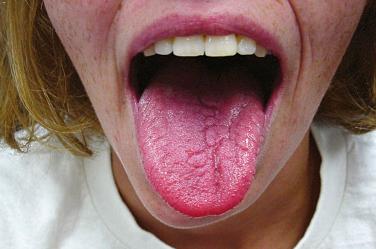
The differential diagnosis of morphea includes a number of morpheaform conditions or morphea mimics, some of the most clinically relevant including radiation-induced morphea, cutaneous malignancy, injection site reactions, and lipodermatosclerosis ( Table 3-1 ).
Radiation-induced morphea may be a subtype of “true” morphea triggered by radiation-related immunologic aberration in the affected skin. Radiation-induced morphea typically presents within 1 year after completion of radiation treatment, though delayed presentations can occur. Radiation-induced morphea is most common in women following radiation for breast cancer, where it presents with shrinkage of the affected breast, distinguishing it from radiation dermatitis. In this clinical scenario, biopsy is indicated to rule out recurrent malignancy, primary malignancy (e.g., basal cell carcinoma), and metastatic disease (e.g., carcinoma en cuirasse).
Injection-site reactions and lipodermatosclerosis may also mimic morphea. Cutaneous sclerosis at injection sites has been reported with vitamin B 12 and vitamin K injections, vaccinations, and other injectables. Lesions tend to slowly resolve without treatment. Lipodermatosclerosis, or sclerosing panniculitis, is a manifestation of venous insufficiency identifiable by its typical features of induration and hyperpigmentation along the lower medial aspect of the leg, with a classic “inverted champagne bottle” appearance. Findings may be either unilateral or bilateral and can occasionally simulate morphea or eosinophilic fasciitis. Lipodermatosclerosis is often a clinical diagnosis; biopsy may be deferred in typical cases due to compromised healing of affected regions.
Several treatment algorithms for morphea have recently been proposed. Treatment for morphea is generally tailored to the condition’s activity, severity, subtype, and potential functional and cosmetic implications. Of note, there is little evidence for the treatment of inactive morphea. Some treatment considerations with respect to disease subtype are as follows.
Become a Clinical Tree membership for Full access and enjoy Unlimited articles
If you are a member. Log in here